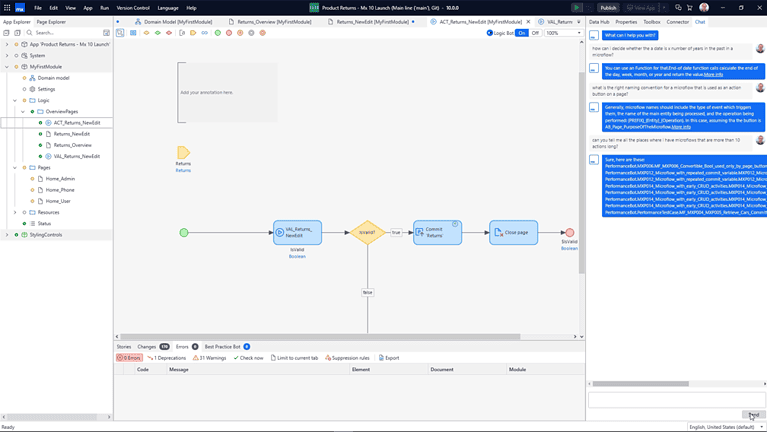Mendix officially unveils its latest generation low-code platform. The biggest improvements concentrate on AI and composability.
Mendix 10 constitutes the latest version of the low-code platform. We encounter some old acquaintances such as a focus on collaboration through integrating the new Portfolio Manager, where teams can plan, track and optimize their goals. In addition, we again see new AI features and a focus on the composable enterprise.
Furthermore, a collaboration between the low-code platform and AWS has been established, giving AWS customers additional capabilities and first access to the new Private Mendix Platform. That platform should be there for customers with needs for the speed and agility of the Mendix platform while adhering to a policy for fully self-managed environments.
Third-generation AI
Although Mendix 10 vehemently emphasizes artificial intelligence and machine learning, we hear from Koert Hagoort, SVP of R&D at Mendix, that AI already found its way within the platform some four years ago. It is therefore the third generation of AI tools in the platform. “We now see because of the hype around ChatGPT that everything has shifted to generative AI, but the technology can be used much more broadly than is currently happening.” To reap the benefits of the hype, Mendix already introduced AI functionalities in a separate announcement.
To integrate use cases for AI, Mendix released a new ML Kit in the latest version of its platform. “With this, we enable customers to connect their AI models to Mendix. The problem is that these models are often created in a different programming language, so it is not easy to link the model to an external platform without immediately flying into high costs.”
Is low-code disappearing because of AI?
Although in Mendix 10 generative AI and low-code find each other, the question is whether artificial intelligence will not take over low-code with time. This appears to be an important topic even within the walls of the low-code specialist because Hagoort immediately has an answer ready for us: “Through AI, we can grow to a platform where a visual representation (low-code) is created from the spoken language. Just because of the visual representation, it is also easy to follow for employees who are not developers. Therefore we see AI as a complement to low-code.”
Certainly, at this time, the SVP sees a valuable role for the low-code developer. After all, code generation via a chatbot is still far from perfect. Bugs creep in, or the use case deviates completely from the user’s requests. “At that point, it is almost impossible for non-developers to extract errors from the code.”
Composable enterprise
Another key pillar of Mendix 10 is the “Composable Enterprise. The company strongly believes that in the future, all companies will build new applications as a composite of internal and external components that may or may not have been used. “In many cases, it is not in the customer’s interest to completely rewrite a system. A much more natural way of working is to constantly replace small pieces of applications so that the investment is spread out.”
To this end, Mendix 10 is bringing Solutions Kit into public availability. This is a collection of capabilities, which includes IP protection and lifecycle management. Further demonstrating the company’s commitment to composability is upgrading the Mendix Connect integration suite. Improvements are being made to the data catalog and new connectors continue to integrate. Finally, the new version of the platform brings support for event-driven architectures.
Market-driven
Mendix got its input for the upcoming changes from a variety of angles. There are three official platforms through which customer interactions are established.
It starts with the ‘customer advisory board,’ in which C-level of Mendix’s major customers is invited to sit around the table with Mendix’s management. Then there is the ‘pioneers program’ for those customers who have the potential to grow from a small number of applications. According to Hagoort, the mix of IT management and developers provides valuable input for the company on day-to-day issues. Finally, there is the ‘community level’ where Mendix mainly tests its beta projects.
